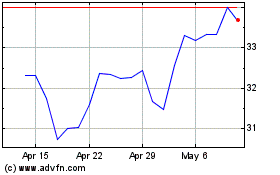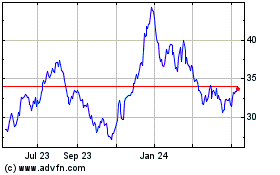UPDATE: Nvidia's 1Q Profits Fall, But Tegra Chip Sales Rise
May 12 2011 - 6:00PM
Dow Jones News
Nvidia Corp. (NVDA) fiscal first-quarter profit slid 1.7% on
lower revenue, but results and second-quarter guidance were better
than expected on solid results at the semiconductor company's core
graphics business and emerging mobile business.
The Santa Clara, Calif.-based maker of graphics chips used for
video games and other visually intensive applications has benefited
of late from its strong position in smartphones and tablets. Its
Tegra applications processor has netted many key design wins,
including the Xoom tablet from Motorola Mobility Holdings Inc.
(MMI), and has helped offset sluggish PC sales.
"This quarter, our Tegra mobile business took off," President
and Chief Executive Jen-Hsun Huang said.
The company has said revenue from Tegra could total $400 million
to $600 million this year, pegging the first quarter level at
"easily over" $100 million. Nvidia on Thursday said its consumer
products business, which includes Tegra and embedded products,
posted revenue of $122.6 million in the quarter, up 78%
sequentially.
"The real question is going to be what the guide is for Tegra in
the next quarter," Needham analyst Rajvindra Gill said. "What we
might have seen was companies building orders [in the first period]
and drawing down inventory in the next quarter as they see what
sell-through is. If this run rate is [over $100 million] and
ramping, that's pretty good."
Nvidia shares, up 40% over the past 12 months through Thursday's
close, slipped 1% to $20.30 in after-hours trading.
Over the past year, the stock has outperformed the 19% rise in
the Philadelphia Semiconductor Index, due to Nvidia's perceived
turnaround. After several quarters of product delays and other
struggles, Nvidia in 2010 posted revenue growth for the first time
in a couple years and it has positioned itself as a leader in the
mobile market.
To strengthen its foothold in that industry, Nvidia on Monday
said it agreed to buy wireless chip maker Icera for $367 million in
cash. The acquisition, expected to close by the beginning of June,
will allow the company to eventually integrate its applications
processor with a modem on the same piece of silicon, appealing to
lower-end smartphones. Nvidia expects the deal to slightly trim its
operating profit through the first half of the 2012 calendar year
and add to it in the second half of next year.
The company also has set its sights on the mainstream computing
market, saying earlier this year that it's developing a chip that
makes it a direct challenger to Intel Corp. (INTC) and Advanced
Micro Devices Inc. (AMD).
For the quarter ended May 1, Nvidia reported a profit of $135.2
million, or 22 cents a share, down from $137.6 million, or 23 cents
a share, a year earlier. Excluding stock-based compensation and
other impacts, adjusted per-share earnings fell to 27 cents from 29
cents. Analysts polled by Thomson Reuters expected a profit of 19
cents a share.
Revenue declined 4% to $962 million. In February, the company
projected revenue would rise 6% to 8% from the fourth quarter,
placing the range at about $939.6 million to $957.3 million.
Results benefited from one month of revenue from a patent
cross-license agreement with Intel. Intel agreed to pay Nvidia $1.5
billion over five years under a deal that also ended litigation
between the companies.
Gross margin widened to 50.4% from 45.6%.
Looking ahead, the company forecast current-quarter revenue
would rise 4% to 6% sequentially to $1 billion to $1.02 billion,
excluding the Icera deal. Analysts expected a 3.1% increase to $992
million.
-By Shara Tibken, Dow Jones Newswires; 212-416-2189;
shara.tibken@dowjones.com
(John Kell contributed to this report.)
Marcus and Millichap (NYSE:MMI)
Historical Stock Chart
From May 2024 to Jun 2024

Marcus and Millichap (NYSE:MMI)
Historical Stock Chart
From Jun 2023 to Jun 2024
